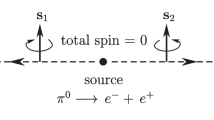Abstract
For a two-qubit state, the isotropic strength measures the degree of isotropic spin correlation. The concept of isotropic strength is generalized to multipartite qudit systems, and the strength distributions for tripartite and quadripartite qudit systems are thoroughly investigated. We show that the sum of relative isotropic strengths of any three-qudit state over d-dimensional Hilbert space cannot exceed \(d-1\), which generalizes the case \(d=2\). The trade-off relations and monogamy-like relations of the sum of spin correlation strengths for pure three- and four-partite systems are derived. Moreover, the bounds of spin correlation strengths among different subsystems of a quadripartite state are used to analyze quantum entanglement.
Similar content being viewed by others
References
Gamel, O.: Entangled Bloch spheres: Bloch matrix and two-qubit state space. Phys. Rev. A 93, 062320 (2016)
Horodecki, R., Horodecki, P., Horodecki, M., Horodecki, K.: Quantum entanglement. Rev. Mod. Phys. 81, 865 (2009)
Brunner, N., Cavalcanti, D., Pironio, S., Scarani, V., Wehner, S.: Bell nonlocality. Rev. Mod. Phys. 86, 419 (2014)
Modi, K., Brodutch, A., Cable, H., Paterek, T., Vedral, V.: The classical-quantum boundary for correlations: discord and related measures. Rev. Mod. Phys. 84, 1655 (2012)
Nielsen, M.A., Chuang, I.L.: Quantum computation and quantum information. Cambridge University Press, Cambridge (2010)
Coffman, V., Kundu, J., Wootters, W.K.: Distributed entanglement. Phys. Rev. A 61, 052306 (2000)
Badzikag, P., Brukner, C., Laskowski, W., Paterek, T., Zukowski, M.: Experimentally friendly geometrical criteria for entanglement. Phys. Rev. Lett. 100, 140403 (2008)
de Vicente, J.I.: Separability criteria based on the Bloch representation of density matrices. Quantum Inf. Comput. 7, 624 (2007)
Hassan, A.S.M., Joag, P.S.: Separability criterion for multipartite quantum states based on the Bloch representation of density matrices. Quantum Inf. Comput. 8, 773 (2007)
Gühne, O., Tóth, G.: Entanglement detection. Phys. Rep. 474, 1 (2009)
de Vicente, J.I., Huber, M.: Multipartite entanglement detection from correlation tensors. Phys. Rev. A 84, 062306 (2011)
Ma, Z.H., Chen, Z.H., Chen, J.L., Spengler, Ch., Gabriel, A., Huber, M.: Measure of genuine multipartite entanglement with computable lower bounds. Phys. Rev. A 83, 062325 (2011)
Chen, Z.H., Ma, Z.H., Chen, J.L., Severini, S.: Improved lower bounds on genuine-multipartite-entanglement concurrence. Phys. Rev. A 85, 062320 (2012)
Li, M., Jia, L., Wang, J., Shen, S., Fei, S.M.: Measure and detection of genuine multipartite entanglement for tripartite systems. Phys. Rev. A 96, 052314 (2017)
Li, M., Shen, S., Jing, N., Fei, S.M., Li-Jost, X.Q.: Tight upper bound for the maximal quantum value of the Svetlichny operators. Phys. Rev. A 96, 042323 (2017)
Ollivier, H., Zurek, W.H.: Quantum discord: a measure of the quantumness of correlations. Phys. Rev. Lett. 88, 017901 (2001)
Henderson, L., Vedral, V.: Classical, quantum and total correlations. J. Phys. A 34, 6899 (2001)
Dakić, B., Vedral, V.: Necessary and sufficient condition for nonzero quantum discord. Phys. Rev. Lett. 105, 190502 (2010)
Dür, W., Vidal, G., Cirac, J.I.: Three qubits can be entangled in two inequivalent ways. Phys. Rev. A 62, 062314 (2001)
Luo, S.L., Fu, S.S.: Geometric measure of quantum discord. Phys. Rev. A 82, 034302 (2010)
Wiseman, H.M., Jones, S.J., Doherty, A.C.: Steering, entanglement, nonlocality, and the Einstein–Podolsky–Rosen paradox. Phys. Rev. Lett. 98, 140402 (2007)
Jevtic, S., Pusey, M., Jennings, D., Rudolph, T.: Quantum steering ellipsoids. Phys. Rev. Lett. 113, 020402 (2014)
Milne, A., Jevtic, S., Jennings, D., Wiseman, H., Rudolph, T.: Quantum steering ellipsoids, extremal physical states and monogamy. New J. Phys. 16, 083017 (2014)
Jevtic, S., Hall, M.J.W., Anderson, M.R., Zwierz, M., Wiseman, H.M.: Einstein–Podolsky–Rosen steering and the steering ellipsoid. J. Opt. Soc. Am. B 32(A), 40 (2015)
Cheng, S., Milne, A., Hall, M.J.W., Wiseman, H.M.: Volume monogamy of quantum steering ellipsoids for multiqubit systems. Phys. Rev. A 94, 042105 (2016)
Zhang, C., Cheng, S., Li, L., Liang, Q.Y., et al.: Experimental validation of quantum steering ellipsoids and tests of volume monogamy relations. Phys. Rev. Lett. 122, 070402 (2019)
Bell, J.S.: On the Einstein–Podolsky–Rosen paradox. Physics 1, 195 (1965)
Clauser, J.F., Horne, M.A., Shimony, A., Holt, R.A.: Proposed experiment to test local hidden-variable theories. Phys. Rev. Lett. 23, 880 (1969)
Horodecki, R., Horodecki, P., Horodecki, M.: Violating Bell inequality by mixed spin-\(\frac{1}{2}\) states: necessary and sufficient condition. Phys. Lett. A 200, 340 (1995)
Wang, Z., Qiao, J., Wang, J., et al.: The norms of Bloch vectors and a trade-off relation of Svetlichny inequalities. Quantum Inf. Process. 17, 220 (2018)
Cheng, S., Hall, M.J.W.: Anisotropic invariance and the distribution of quantum correlations. Phys. Rev. Lett. 118, 010401 (2017)
Acknowledgements
We thank Jun Li for helpful discussions on entanglement detection and related problems. This work is partially supported by National Natural Science Foundation Grant No. 11531004, Simons Foundation Grant No. 523868 and a grant from China Scholarship Council.
Author information
Authors and Affiliations
Corresponding author
Additional information
Publisher's Note
Springer Nature remains neutral with regard to jurisdictional claims in published maps and institutional affiliations.
Rights and permissions
About this article
Cite this article
Yu, B., Jing, N. & Li-Jost, X. Distribution of spin correlation strengths in multipartite systems. Quantum Inf Process 18, 344 (2019). https://doi.org/10.1007/s11128-019-2458-4
Received:
Accepted:
Published:
DOI: https://doi.org/10.1007/s11128-019-2458-4




